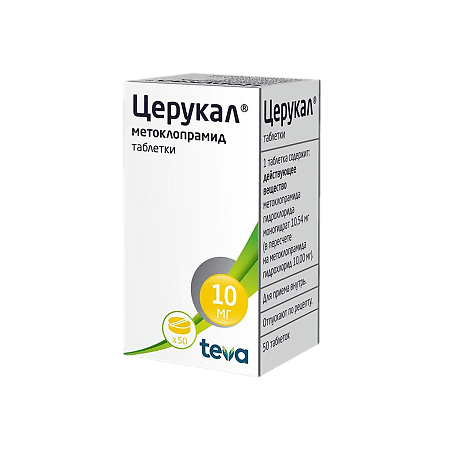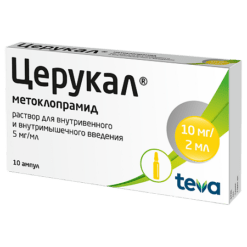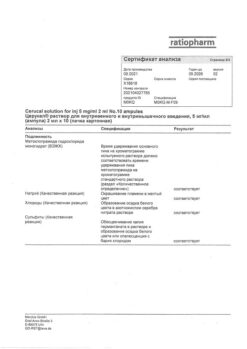No products in the cart.
Cerucal, tablets 10 mg 50 pcs
€5.93 €3.99
Description
Pharmacotherapeutic group: A central dopamine receptor blocker.
ATX code: A03FA01
Pharmacological properties
Pharmacodynamics
p> Antiemetic, is a specific blocker of dopamine (D2) and serotonin receptors. The mechanism of action is based on both the central and peripheral effects of metoclopramide. The antiemetic effect is associated with blockade of dopamine receptors in the brain, which causes an increase in the threshold of irritation of the vomiting center. It has antiemetic effect, eliminates nausea and hiccups. It reduces esophageal motility, increases the tone of the lower esophageal sphincter, accelerates gastric emptying, and also accelerates the movement of food through the small intestine without causing diarrhea. Normalizes bile secretion, reduces spasm of Oddi sphincter, does not change its status, eliminates gall bladder dyskinesia. Stimulates the secretion of prolactin.
Pharmacokinetics
After oral administration is rapidly absorbed, time to reach maximum plasma concentration 30-120 minutes. Bioavailability is 60-80%.
It is metabolized in the liver. Elimination half-life is 3 to 5 hours; in renal function disorders it may be increased up to 14 hours. It is excreted by kidneys during the first 24 hours unchanged and as metabolites (about 80% of the dose taken). It easily passes through the blood-brain barrier and is excreted with breast milk.
Indications
Indications
Prevention of postoperative nausea and vomiting.
Symptomatic treatment of nausea and vomiting, including acute migraine.
Prevention of nausea and vomiting caused by radiation therapy and chemotherapy.
Pharmacological effect
Pharmacological effect
Pharmacotherapeutic group: Antiemetic – central dopamine receptor blocker.
ATX code: A03FA01
Pharmacological properties
Pharmacodynamics
An antiemetic, it is a specific blocker of dopamine (D2) and serotonin receptors. The mechanism of action is based on both the central and peripheral effects of metoclopramide. The antiemetic effect is associated with the blockade of dopamine receptors in the brain, which causes an increase in the threshold of irritation of the vomiting center. Has an antiemetic effect, eliminates nausea and hiccups. Reduces motor activity of the esophagus, increases the tone of the lower esophageal sphincter, accelerates gastric emptying, and also accelerates the movement of food through the small intestine without causing diarrhea. Normalizes bile secretion, reduces spasm of the sphincter of Oddi, does not change its status, eliminates gallbladder dyskinesia. Stimulates the secretion of prolactin.
Pharmacokinetics
After oral administration, it is quickly absorbed, the time to reach maximum concentration in blood plasma is 30-120 minutes. Bioavailability is 60-80%.
Metabolized in the liver. The half-life is from 3 to 5 hours; in case of impaired renal function, it can increase to 14 hours. It is excreted by the kidneys during the first 24 hours unchanged and in the form of metabolites (about 80% of the dose taken). Easily penetrates the blood-brain barrier and is excreted in breast milk.
Special instructions
Special instructions
Caution should be exercised when using Cerucal® in elderly patients.
From the nervous system, extrapyramidal disorders are possible, especially in children and young patients and/or when using high doses, usually developing at the beginning of treatment or after a single use. The use of Cerucal® should be stopped immediately if extrapyramidal symptoms occur. The reactions are completely reversible after cessation of treatment, but may require symptomatic therapy (benzodiazepines in children and/or anticholinergic antiparkinsonian drugs in adults).
To avoid an overdose of the drug Cerucal®, it is necessary to observe a minimum interval between doses of 6 hours, even in case of vomiting.
Long-term treatment with Cerucal® may lead to the development of tardive dyskinesia, which is potentially irreversible, especially in elderly patients. The duration of treatment should not exceed 3 months due to the risk of developing tardive dyskinesia. If there are signs of tardive dyskinesia, treatment should be stopped.
When metoclopramide was used simultaneously with neuroleptics, as well as with metoclopramide monotherapy, neuroleptic malignant syndrome was observed. It is necessary to immediately stop treatment with Cerucal® if symptoms of neuroleptic malignant syndrome appear and apply appropriate therapy.
Caution should be exercised when used in patients with concomitant neurological diseases and in patients taking drugs that affect the central nervous system.
When using the drug Cerucal®, symptoms of Parkinson’s disease may also occur.
Cases of methemoglobinemia, which could be caused by a deficiency of the enzyme NADH-dependent cytochrome b5 reductase, have been reported. In this case, taking the drug Cerucal® must be stopped immediately and completely and appropriate measures must be taken.
Severe cardiovascular side effects have been reported, including vascular insufficiency, severe bradycardia, cardiac arrest, and QT prolongation.
Caution should be exercised when using the drug Cerucal® in elderly patients, patients with cardiac disorders (including prolongation of the QT interval), patients with fluid and electrolyte imbalance, bradycardia and in patients taking other drugs that prolong the QT interval.
For moderate to severe renal failure and severe hepatic failure, a dose reduction is recommended (see section “Dosage and Administration”).
Impact on the ability to drive vehicles and machinery
Care should be taken when driving vehicles and other machinery, because taking the drug may cause drowsiness and dyskinesia.
Active ingredient
Active ingredient
Metoclopramide
Composition
Composition
1 tablet contains: active ingredient metoclopramide hydrochloride monohydrate 10.54 mg (in terms of metoclopramide hydrochloride 10.00 mg); excipients: potato starch 36.75 mg, lactose monohydrate 76.65 mg, gelatin 2.16 mg, colloidal silicon dioxide 2.60 mg, magnesium stearate 1.30 mg, purified water q.s.
Pregnancy
Pregnancy
Pregnancy
Numerous data obtained on use in pregnant women (more than 1000 described cases) indicate the absence of fetotoxicity and the ability to cause malformations in the fetus. Metoclopramide can be used during pregnancy (I-II trimesters) only if the potential benefit to the mother outweighs the potential risk to the fetus. Due to pharmacological characteristics (similar to other antipsychotics), when using metoclopramide at the end of pregnancy, the possibility of developing extrapyramidal symptoms in the newborn cannot be excluded. Metoclopramide should not be used at the end of pregnancy (during the third trimester). When using metoclopramide, the condition of the newborn should be monitored.
Breastfeeding period
Metoclopramide is excreted in small amounts into breast milk. The possibility of adverse reactions in a child cannot be ruled out. The use of metoclopramide during breastfeeding is not recommended. If it is necessary to use the drug during lactation, breastfeeding should be stopped.
Contraindications
Contraindications
Hypersensitivity to metoclopramide and the components of the drug;
gastrointestinal bleeding, mechanical intestinal obstruction or perforation of the stomach and intestinal wall, conditions in which stimulation of gastrointestinal motility poses a risk;
confirmed or suspected pheochromocytoma due to the risk of developing severe arterial hypertension;
tardive dyskinesia that developed after a history of treatment with antipsychotics or metoclopramide;
epilepsy (increased frequency and severity of seizures);
Parkinson’s disease;
simultaneous use with levodopa and dopamine receptor agonists;
methemoglobinemia due to metoclopramide or a history of nicotinamide adenine dinucleotide (NADH) cytochrome b5 deficiency;
prolactinoma or prolactin-dependent tumor;
lactase deficiency, lactose intolerance, glucose-galactose malabsorption;
children under 15 years of age;
breastfeeding period.
With caution
When used in elderly patients; in patients with cardiac conduction disorders (including prolongation of the QT interval), impaired water and electrolyte balance, bradycardia, taking other drugs that prolong the QT interval, arterial hypertension; in patients with concomitant neurological diseases, depression (history); with renal failure of moderate and severe severity (creatinine clearance 15-60 ml/min); with severe liver failure; during pregnancy.
Side Effects
Side Effects
The frequency of adverse reactions is classified as follows: very common (≥ 1/10), common (≥ 1/100 – < 1/10), uncommon (≥ 1/1000 - < 1/100), rare (≥ 1/10000 - < 1/1000), very rare (< 1/10000), frequency unknown (cannot be estimated based on available data).
Blood and lymphatic system disorders: frequency unknown – methemoglobinemia, probably associated with deficiency of the enzyme NADH-dependent cytochrome b5 reductase, especially in newborns, sulfhemoglobinemia (most often with simultaneous use of high doses of sulfur-containing drugs), leukopenia, neutropenia, agranulocytosis.
Immune system disorders: uncommon – hypersensitivity; frequency unknown – anaphylactic reactions (including anaphylactic shock), allergic reactions (urticaria, maculopapular rash).
Endocrine system disorders*: uncommon – amenorrhea, hyperprolactinemia; rarely – galactorrhea; frequency unknown – gynecomastia.
*Endocrine disorders during long-term treatment are associated with hyperprolactinemia (amenorrhea, galactorrhea, gynecomastia).
Mental disorders: often – depression; infrequently – hallucinations; rarely – confusion.
Nervous system disorders: very often – drowsiness; often – asthenia, extrapyramidal disorders (especially in children and young patients and/or when recommended doses of the drug are exceeded, even after a single administration), parkinsonism, akathisia; infrequently – dystonia (including blurred vision and involuntary movement of the eye – oculogeric crisis), dyskinesia, impaired consciousness; rarely – seizures, especially in patients with epilepsy; frequency unknown – tardive dyskinesia, sometimes persistent, during or after long-term treatment, especially in elderly patients, neuroleptic malignant syndrome.
Cardiac disorders: infrequently – bradycardia; frequency unknown – cardiac arrest, which may be caused by bradycardia, atrioventricular block, sinus node block, prolongation of the QT interval on the electrocardiogram, pirouette-type arrhythmia.
Vascular disorders: often – low blood pressure; frequency unknown – cardiogenic shock, acute increase in blood pressure in patients with pheochromocytoma, transient increase in blood pressure.
Gastrointestinal disorders: often – nausea, diarrhea, constipation.
Renal and urinary tract disorders: frequency unknown – polyuria, urinary incontinence.
Genital and breast disorders: unknown frequency – sexual dysfunction, priapism.
Adverse reactions most common when using high doses of the drug
– Extrapyramidal symptoms: acute dystonia and dyskinesia, parkinsonism syndrome, akathisia developed even after using a single dose of the drug, especially in children and young patients (see section “Special instructions”).
– Drowsiness, decreased level of consciousness, confusion, hallucinations.
Interaction
Interaction
The simultaneous use of metoclopramide with levodopa or dopamine receptor agonists is contraindicated due to the existing mutual antagonism.
Alcohol enhances the sedative effect of metoclopramide.
Combinations requiring caution
Due to the prokinetic effect of metoclopramide, the absorption of some drugs may be impaired.
M-anticholinergic agents and morphine derivatives have mutual antagonism with metoclopramide in terms of their effect on gastrointestinal motility.
Medicines that depress the central nervous system (morphine derivatives, tranquilizers, H1-histamine blockers, antidepressants with sedative effects, barbiturates, clonidine and other drugs of these groups) can enhance the sedative effect under the influence of metoclopramide.
Metoclopramide enhances the effect of antipsychotics on extrapyramidal symptoms.
With concomitant oral use of metoclopramide and tetrabenazine, there is a possibility of dopamine deficiency, which may be accompanied by increased muscle stiffness or spasm, difficulty speaking or swallowing, anxiety, tremor, involuntary muscle movements, including facial muscles.
The use of metoclopramide with serotonergic drugs, such as selective serotonin reuptake inhibitors, increases the risk of developing serotonin syndrome (serotonin toxicity).
Metoclopramide reduces the bioavailability of digoxin. The concentration of digoxin in the blood plasma should be monitored.
Metoclopramide increases the bioavailability of cyclosporine (Cmax by 46% and exposure by 22%). It is necessary to carefully monitor the concentration of cyclosporine in the blood plasma. The clinical consequences of this interaction have not been established.
Metoclopramide exposure increases when used concomitantly with strong CYP2D6 inhibitors, such as fluoxetine and paroxetine. Although the clinical significance of this interaction has not been established, patients should be monitored for adverse reactions.
With the concomitant use of metoclopramide with atovaquone, the concentration of atovaquone in the blood plasma is significantly reduced (about 50%). Concomitant use of metoclopramide with atovaquone is not recommended.
With the concomitant use of metoclopramide with bromocriptine, the concentration of bromocriptine in the blood plasma increases.
Metoclopramide enhances the absorption of tetracycline from the small intestine.
Metoclopramide enhances the absorption of mexiletine and lithium.
Metoclopramide reduces the absorption of cimetidine.
Overdose
Overdose
Symptoms
Extrapyramidal disorders, drowsiness, decreased level of consciousness, confusion, hallucinations, irritability, dizziness, bradycardia, changes in blood pressure, cardiac and respiratory arrest, abdominal pain.
Treatment
In the event of the development of extrapyramidal symptoms caused by overdose or for another reason, treatment is exclusively symptomatic (benzodiazepines in children and/or anticholinergic antiparkinsonian drugs in adults).
Symptomatic treatment and constant monitoring of cardiac and respiratory functions are required depending on the clinical condition of the patient.
There is no specific antidote.
Storage conditions
Storage conditions
Store at a temperature not exceeding 25 °C in the original packaging.
KEEP OUT OF REACH OF CHILDREN!
Shelf life
Shelf life
5 years
Manufacturer
Manufacturer
Pliva Hrvatska d.o.o., Croatia
Additional information
| Shelf life | 5 years |
|---|---|
| Conditions of storage | Store at a temperature not exceeding 25 oC in the original package. KEEP OUT OF REACH OF CHILDREN! |
| Manufacturer | Pliva Hrvatska d.o.o., Croatia |
| Medication form | pills |
| Brand | Pliva Hrvatska d.o.o. |
Other forms…
Related products
Buy Cerucal, tablets 10 mg 50 pcs with delivery to USA, UK, Europe and over 120 other countries.
















